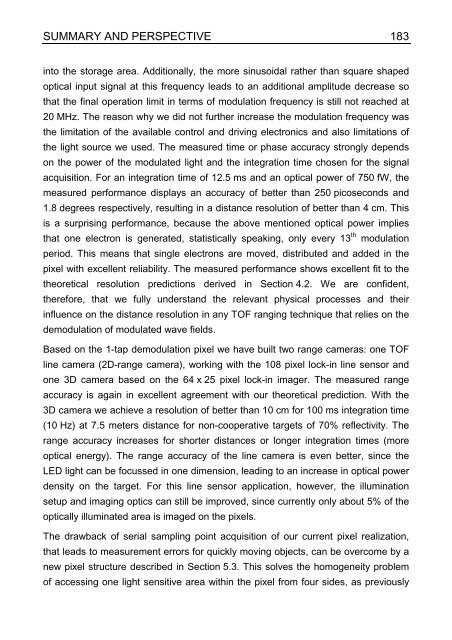3D Time-of-flight distance measurement with custom - Universität ...
3D Time-of-flight distance measurement with custom - Universität ...
3D Time-of-flight distance measurement with custom - Universität ...
Create successful ePaper yourself
Turn your PDF publications into a flip-book with our unique Google optimized e-Paper software.
SUMMARY AND PERSPECTIVE 183<br />
into the storage area. Additionally, the more sinusoidal rather than square shaped<br />
optical input signal at this frequency leads to an additional amplitude decrease so<br />
that the final operation limit in terms <strong>of</strong> modulation frequency is still not reached at<br />
20 MHz. The reason why we did not further increase the modulation frequency was<br />
the limitation <strong>of</strong> the available control and driving electronics and also limitations <strong>of</strong><br />
the light source we used. The measured time or phase accuracy strongly depends<br />
on the power <strong>of</strong> the modulated light and the integration time chosen for the signal<br />
acquisition. For an integration time <strong>of</strong> 12.5 ms and an optical power <strong>of</strong> 750 fW, the<br />
measured performance displays an accuracy <strong>of</strong> better than 250 picoseconds and<br />
1.8 degrees respectively, resulting in a <strong>distance</strong> resolution <strong>of</strong> better than 4 cm. This<br />
is a surprising performance, because the above mentioned optical power implies<br />
that one electron is generated, statistically speaking, only every 13 th modulation<br />
period. This means that single electrons are moved, distributed and added in the<br />
pixel <strong>with</strong> excellent reliability. The measured performance shows excellent fit to the<br />
theoretical resolution predictions derived in Section 4.2. We are confident,<br />
therefore, that we fully understand the relevant physical processes and their<br />
influence on the <strong>distance</strong> resolution in any TOF ranging technique that relies on the<br />
demodulation <strong>of</strong> modulated wave fields.<br />
Based on the 1-tap demodulation pixel we have built two range cameras: one TOF<br />
line camera (2D-range camera), working <strong>with</strong> the 108 pixel lock-in line sensor and<br />
one <strong>3D</strong> camera based on the 64 x 25 pixel lock-in imager. The measured range<br />
accuracy is again in excellent agreement <strong>with</strong> our theoretical prediction. With the<br />
<strong>3D</strong> camera we achieve a resolution <strong>of</strong> better than 10 cm for 100 ms integration time<br />
(10 Hz) at 7.5 meters <strong>distance</strong> for non-cooperative targets <strong>of</strong> 70% reflectivity. The<br />
range accuracy increases for shorter <strong>distance</strong>s or longer integration times (more<br />
optical energy). The range accuracy <strong>of</strong> the line camera is even better, since the<br />
LED light can be focussed in one dimension, leading to an increase in optical power<br />
density on the target. For this line sensor application, however, the illumination<br />
setup and imaging optics can still be improved, since currently only about 5% <strong>of</strong> the<br />
optically illuminated area is imaged on the pixels.<br />
The drawback <strong>of</strong> serial sampling point acquisition <strong>of</strong> our current pixel realization,<br />
that leads to <strong>measurement</strong> errors for quickly moving objects, can be overcome by a<br />
new pixel structure described in Section 5.3. This solves the homogeneity problem<br />
<strong>of</strong> accessing one light sensitive area <strong>with</strong>in the pixel from four sides, as previously

















